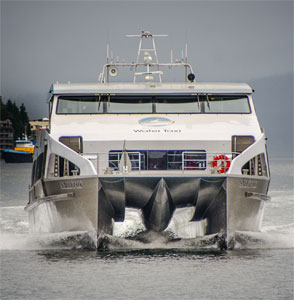For the 200 commuters disembarking on Seattle’s Pier 50 from Vashon Island on a drizzly July morning, their crisp new ride — the catamaran Sally Fox — provided a bright way to start the day.
The 105-foot, 278-passenger ferry, designed by Teknicraft of New Zealand and built by All American Marine in Bellingham, Wash., began service on April 8, 2015. It replaced Melissa Ann, a 72-foot, 172-passenger catamaran built by Nichols Brothers Boat Builders in Freeland, Wash., in 1988.
The new vessel is named after Sally Fox, a longtime advocate for the preservation of passenger-only ferry service between Seattle and Vashon Island. Washington State Ferries ceased the passenger-only run in 2009, prompting King County Water Taxi to lease Melissa Ann from Four Seasons Marine Services and take over the route.
“(Fox) organized rallies when the state was going to cut the service to Vashon Island and is credited with the continuation of service,” said Greg Lerner, shoreside operations manager for King County Water Taxi.
The main advantage of the new ferry compared to its predecessor is its size, said Capt. Dan Krehbiel, at the helm of Sally Fox on the 7:40 a.m. run to Vashon. “This is a bigger boat so it burns more fuel, but per passenger it burns less fuel,” he said.
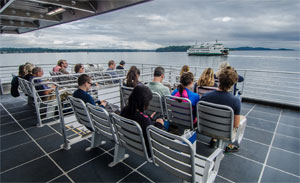 |
|
The 105-foot catamaran from All American Marine can seat 278 passengers — 250 inside and 28 on the upper aft deck. |
The bridge was designed to be as symmetrical as possible so that any of the King County captains can operate the controls from either of the pilot seats. “And I get to sit down,” said Krehbiel. “I had to stand on the other boat. It’s also a much better sea boat, and the passengers love the boat. We are able to have a boat with 278 passengers operated by a crew of three. That makes it very efficient budget-wise. And the boat came in lighter, faster and more efficient than we expected.”
Occasionally, Melissa Ann was forced to shut down because of weather and, at other times, the older catamaran would be forced to slow down to cross the wake of a large containership. So far Sally Fox has not been hampered by weather or wakes, and Krehbiel surmises that the new vessel is much less susceptible to the caprices of air and sea.
The challenge for him is threading through the recreational boaters, other ferries, tugboats, workboats, tour boats, kayaks and standup paddle boarders in Elliott Bay.
“But I enjoy the challenge,” he said. “Otherwise it’s just a bus ride. We stay under 30 knots because we are not rated as a high-speed catamaran. But I’m a high-speed instructor so we train to those standards. It’s the prudent thing to do when you run through Elliott Bay at 28 knots.” It helps that the bridge has four large forward windows and the view out over the bow is virtually unrestricted by blind spots.
The Vashon Island commuter run is 22 minutes. It consists of three return runs in the morning beginning at 5:30 a.m. and three return runs in the afternoon beginning at 4:30 p.m. In winter, that means dark sailing. Krehbiel explained that they use night-vision goggles during the dark winter runs. He speculates that the practice has probably saved some lives, in particular a paddle boarder on one such run.
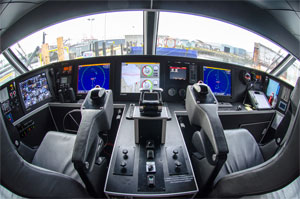 |
|
Sally Fox’s bridge console features an array of Furuno electronics. |
The vessel is wired for a FLIR night-vision system to be installed in the future. There is also a man-overboard platform on the port side with a ladder system that allows for a rescue to be handled by one person. The bow is reinforced to protect against the debris floated off Puget Sound’s shoreline by the tide.
Teknicraft designed Sally Fox using computational fluid dynamics (CFD) and digital modeling to reduce the wake and improve the efficiency of the asymmetrical hulls. Krehbiel explained that the inside edge of each hull is straighter than the outside edge, creating less interplay between the hulls. That reduces the wake and following swell.
“The wake is half of Melissa Ann’s — a big deal in Elliott Bay,” Krehbiel said. Teknicraft’s signature wave piercer, located between the hulls, breaks the wave action to reduce drag and enhance passenger comfort.
The hulls are also roomy, so there is no shoehorning of machinery into a tight tangle of piping, wiring and exhaust manifolds, nor scrambling with head over knee banging hull frames. The machinery spaces sparkle with silvery light reflected off the stretched reinforced foil covering 2 inches of FyreWrap insulation. There is room to stand and it is clean.
“The standing joke aboard is that we should wipe our shoes before going down into the engine room,” said Krehbiel.
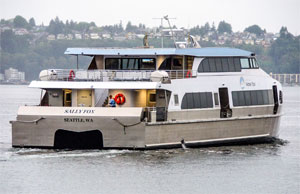 |
|
Capt. Dan Krehbiel guides the ferry on a July run. |
The QSK50 Cummins propulsion incorporates an Eliminator system, developed jointly by Cummins and Alfa Laval. It negates the need for oil filters by screening for particles in the engine oil as small as 20 microns, with a centrifugal separator depositing the particles onto a replaceable liner.
In addition, Sally Fox’s main engines utilize the Centinel system developed by Cummins to automate oil changes. It monitors the engine while it is running and, at precise intervals, bleeds off a small amount of used oil. The oil is sent to the fuel tank, where it blends with diesel fuel and is burned during combustion. At the same time, the burned oil is replenished from a reserve tank. The system eliminates 15 to 20 oil changes between the ferry’s 4,000-hour servicing breaks.
An automatic electrical load-shedding system reduced the size of the two generators — one in each hull — required to meet the vessel’s demands. Hatton Marine of Seattle supplied two 40-kW gensets, each consisting of a Mitsubishi block, Stamford alternator and Yukon generator. The electrical distribution system was configured by Bluefin Marine of Kirkland, Wash.
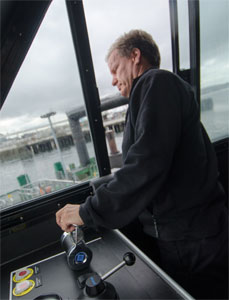 |
|
The boat heads for Vashon Island. |
As one would expect, features complying with the Americans with Disabilities Act (ADA) abound on any new ferry. On Sally Fox, they include wheelchair tie-downs and monitors for the hearing impaired. One of the three restrooms is also ADA-compliant.
There are 26 staggered bicycle racks on the stern, along with dual boarding and offloading doors and ramps that enable the crew to potentially load 106 more passengers on Sally Fox than on Melissa Ann without compromising the ferry’s schedule.
Sally Fox is a U.S. Coast Guard Subchapter K inspected vessel and the first vessel built under the new 5A Space Performance Guidelines, which helped reduce the weight and the cost of the ferry.
Powered by biodiesel mix
• The fuel blend burned aboard Sally Fox is 10 percent biodiesel, primarily made from renewable yellow grease and cooking oils refined locally, and 90 percent diesel.
• Based on the fuel mix, efficient hull design, Tier 3 engines, increased bicycle storage capacity and other measures on Sally Fox and Doc Maynard, King County has been accepted as a member of the Passenger Vessel Association’s Green Waters Program.
• The county’s biodiesel program was spearheaded by Paul Brodeur, director of the Marine Division, who helped implement a similar program as the head of the engineering group at Washington State Ferries.
Jeff Sokolik, project manager at All American Marine, explained that since 1993 the Coast Guard has stipulated that a Type 5 passenger space have 3 pounds per square foot (psf) of fire load and a Type 5A passenger space have 1 pound psf of fire load.
“The 5A could only be applied if you could demonstrate that the fire would not endanger the structure or people, but provided no clear guidance on what would actually pass,” said Sokolik. “Specific goals and the use of fire-scenario modeling (were) developed in 2001, but it was expensive to do and so it was not done very often, if at all.”
In exchange for meeting very specific criteria, the new 5A guidelines eliminated the need for the modeling. For example, the Beurteaux seats and Flexo flooring meet the referenced IMO requirements, so they were not considered to be part of the fire load in the compartments.
“The guidelines allowed us to deduct 0.5 pounds psf of the flooring’s weight because it is IMO rated,” said Sokolik.
Further, the paneling used throughout the vessel is Ayres Ayrlite 2022 — a lightweight non-combustible aluminum honeycomb core sandwiched between aluminum sheets. It was developed by Ayres Composite Panels of Bayswater, Australia, for high-performance vessel interior applications.
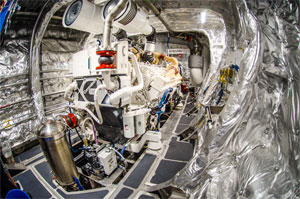 |
|
Twin Cummins QSK50 Tier 3 engines, one in each hull, drive Sally Fox. Each is rated for 1,800 hp at 1,900 rpm. The diesels are coupled to ZF 5055A reduction gears and VEEM propellers. |
“The paneling, with a non-combustible rating that included the laminate facing, was critical to the minimal fire load,” said Sokolik. “Once we met the 5A criteria, the weight and cost of the vessel were lowered because the need for heavy insulation on the superstructure, as well as fire-rated doors, windows and ceilings, was eliminated. The 5A guidelines allowed us to build a cost-effective and efficient boat that still is safe for passengers and crew.”
The Ayres panels also added to the “green” value of the vessel because aluminum is a highly recyclable product. As an environmentally friendly alternative to paint, the decks are covered with peel-and-stick non-slip tread, and the exterior of the superstructure is wrapped in UV-stable vinyl. The only paint on the vessel is bottom paint. Sally Fox also has a zero-discharge system, with all blackwater and graywater going into holding tanks to be pumped ashore.
For security and safety, the ferry has CCTV video surveillance and LED monitors for showing safety videos. A night alarm system sends texts to designated people when the system activates.
A sister ship, Doc Maynard, is scheduled to be delivered in late fall 2015 and will service the Pier 50-West Seattle route. David Swinson “Doc” Maynard was prominent in the founding of Seattle and an advocate for Native American rights.

